The Lenovo ThinkPad A285 (12.5-Inch) Review: Ryzen Pro Gets Down to Business
by Brett Howse on December 18, 2018 8:00 AM EST- Posted in
- Laptops
- AMD
- Lenovo
- ThinkPad
- Vega
- Ryzen
- Ryzen PRO
- Ryzen Mobile
- Vega Mobile
GPU Performance
We’ve tested Raven Ridge before, which is the platform name for Ryzen Mobile, but that was the Ryzen 7 2700U with Vega 10 in the Acer Swift 3. The Thinkpad A285 ships with the Ryzen 5 Pro 2500U, which features the Vega 8 GPU, meaning 8 Vega cores, which means if you do want the best GPU performance you can get in a 15-Watt PC APU, you will have to get the highest-tier Ryzen Mobile.
To test the ThinkPad A285, we ran it through our GPU suite for integrated GPU laptops. If you’d like to compare the A285 to any device not shown in the graphs, please check out our online bench.
3DMark
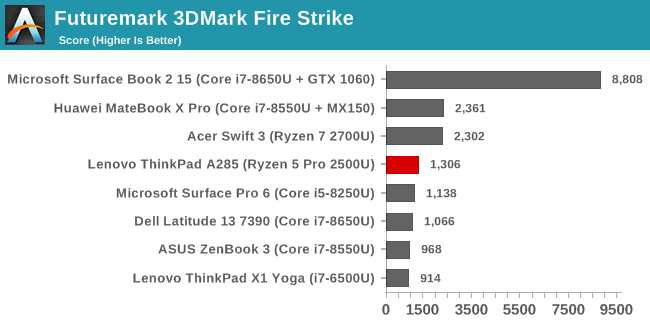

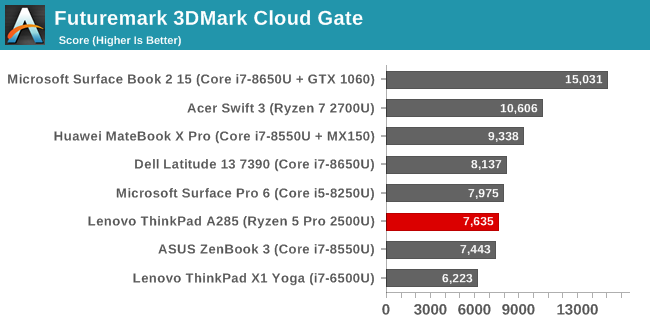
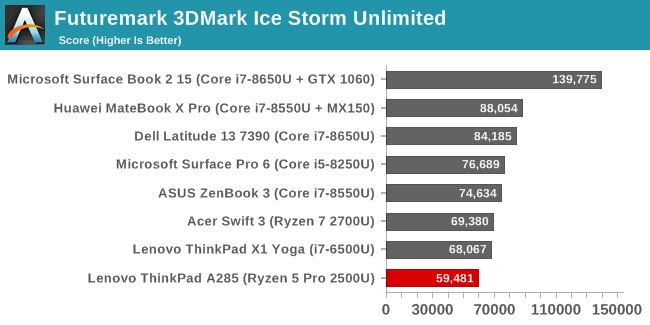
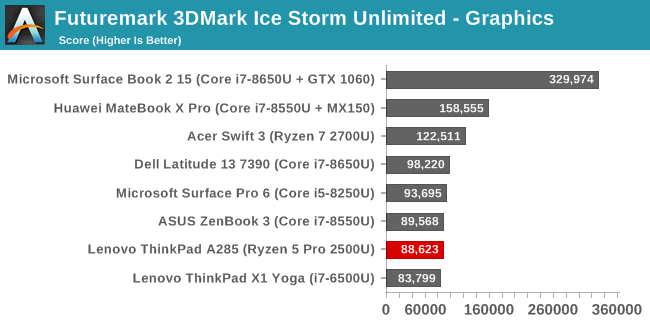
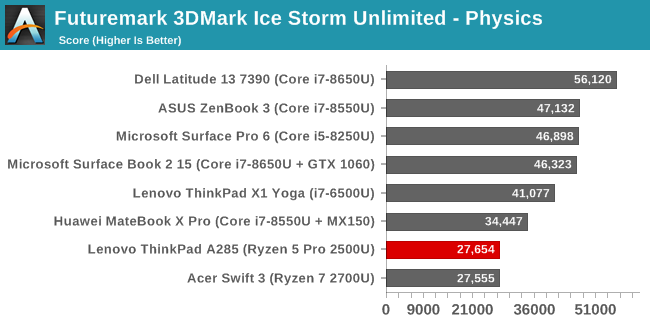
UL Benchmark’s 3DMark offers a set of tests with varying degrees of complexity, with Fire Strike being something made for dGPU devices, and Ice Storm Unlimited the same test they offer on smartphones and tablets.
The ThinkPad A285 with its less-powerful GPU definitely takes a step back from its faster brother in the Acer Swift 3, and coupled with the lower frequency CPU, finds itself more-or-less tied with the Intel iGPU. Which isn’t really praise by any measure. AMD also hasn’t really been updating performance with drivers as quickly as hoped on the Raven Ridge platform for DX11.
GFXBench
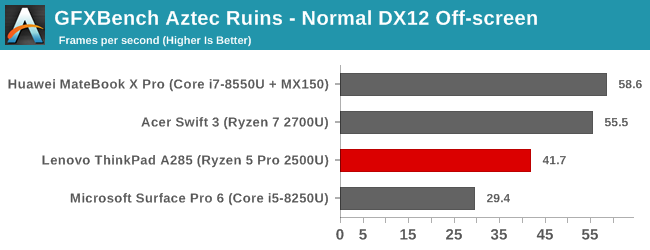
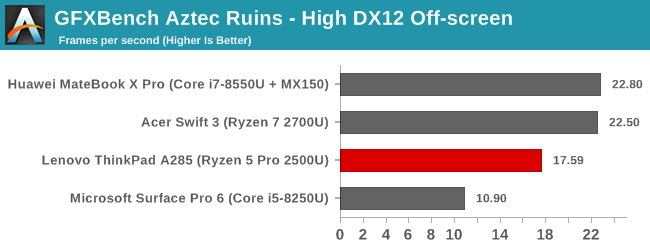
GFXBench has been updated to version 5 on the PC, and brings with it new DX12 tests with the Aztec Ruins scenes. As such, we’ll be transitioning to these new tests as our baseline for GFXBench going forward.
Aztec Ruins offers both a normal (1080p) and high (1440p) mode, and here the Vega 8 does quite a bit better than it did on DX11 with 3DMark. The results on both level are slightly behind the Vega 10 Acer Swift 3, but well ahead of the iGPU in the Surface Pro 6.
Dota 2
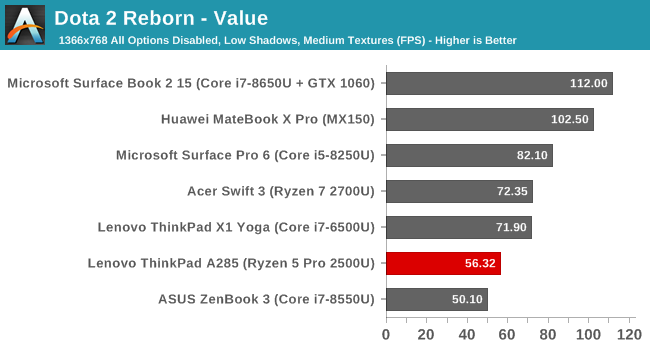
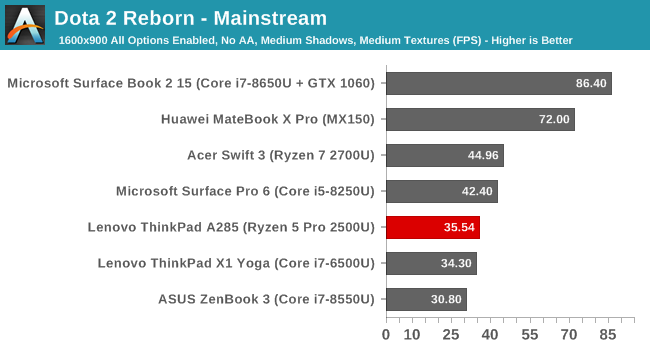
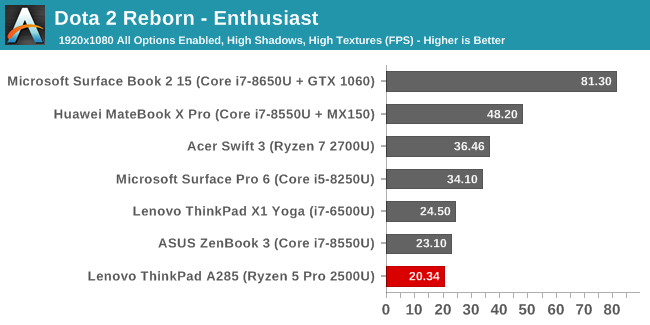
For iGPU laptops, we use Dota 2 as our real-world gaming test, since it’s both a very popular game, and quite adaptable to low-end hardware. Unfortunately, there was no way to run 1366x768, on this device, so it was run at 1280x720 instead. Dota 2 is a DX11 title, and the performance of the ThinkPad is not great here compared to either the Ryzen 7 2700U, or the Intel laptops.
GPU Conclusion
There’s little doubt that Vega can offer a lot more performance than Intel’s iGPU offerings, and we’ve seen that before with the Vega 10, but Vega 8 in the ThinkPad A285 doesn’t offer quite the performance level, especially on DX11 titles, which is still the most popular API on the PC. As a result the iGPU portion of AMD's APU is still competitive with Intel offerings, but it won't offer the kind of class-leading performance that AMD is better known for.










72 Comments
View All Comments
DanNeely - Tuesday, December 18, 2018 - link
Just multiple copies of visual studio combined with being a tab junky in my browsers is enough to make 16gb start to chug. Generally ~20GB used is where it's no longer possible to push only unneeded stuff to swap and performance starts to chug.HStewart - Tuesday, December 18, 2018 - link
Maybe so - but in my development situation at home, I have entire lab with multiple machines - so Visual Studio is primary used for compiling code - I do occasionally use it for debugging like today - but I am old fashion and use a brief editor for writing code.It is funny how extra memory has made developers lazy with development - I remember the old days of even counting clock cycles.
YukaKun - Wednesday, December 19, 2018 - link
"At Home". The context is "Enterprise". If you develop at home, then you have zero clue what we're talking about here?And why blame the developers on management decisions on what they want to utilize inside their ENTERPRISE laptops?
And in particular for how IDEs now work, that is a completely separate discussion. They have way more nanny features, but also better debugging and helpful things as well. When you're developing complex solutions that are far from the old monolithic stuff you might remember, you need to run different flavours of applications and full platforms for testing and developing.
You're really barking at the wrong tree here.
Cheers!
Samus - Tuesday, December 18, 2018 - link
Personally I've always felt 8GB is fine in a mobile device (unless we're talking a Zbook where heavy productivity will take place)The obvious advantages of 8GB in a laptop are faster suspend\sleep\resume times, and less wear on the SSD in doing so, in addition to longer battery life (assuming the tasks you are performing aren't paging to the SSD because you are out of memory) and a lower price.
The base configuration for many PC's, even Microsoft's own Surface, is 4GB, and Windows 10 runs pretty good on 4GB with an SSD.
Again, there are obvious scenarios where 16 and even 32GB will be desirable, but MOST people will not need 16GB with current software and usage trends. I have clients with 30GB OST files and 30 Chrome tabs open on machines with 8GB and they perform great.
YukaKun - Wednesday, December 19, 2018 - link
Do you work for a big Corporation with complex infrastructure and products?I'm not really trying to be an ass, although it might come off as that, but this is one of those where you really need to see it with your own eyes to understand it. I know others know exactly what I'm talking about, so my point is just for the Author of the article to realize some "new facts" about the Enterprise world.
Cheers!
RSAUser - Wednesday, December 19, 2018 - link
That's why it should exist as an option. I no longer have a PC in my household with less than 16GB of RAM. (3 desktops, 4 laptops).For enterprise like e.g. software developers, that extra RAM is basically a requirement for most workloads. I'm currently using 9GB of RAM, 3GB of which is the IDE due to the index on it, and I haven't even started the test bench.
YukaKun - Wednesday, December 19, 2018 - link
Eclipse uses 4GB on it's own; then I have multiple JBoss'es running for different things; each sucking 2GB (sometimes doing 8GB tests) on their own and the rest of the bloatware crap our dear Company decides to pack into the machine. I'm currently with 16GB, but I'm about to ask for another evaluation of needs, because it's just not enough anymore.And this is just Java. Dot Net garbage uses even more, specially when you need to run local DBs and other stuff.
Cheers!
CurbedLarry - Tuesday, December 18, 2018 - link
20 years ago 16 megabytes was enough for office suite and web browsing... Are the machines of today really giving us 1,000 times the performance and functionality?Even mobile apps are now bigger than 90s office suites!
HStewart - Tuesday, December 18, 2018 - link
That is because with extra memory, developers have gotten lazy - I am actually surprise with how small .net executables are - but then that does not count the runtime.Flunk - Tuesday, December 18, 2018 - link
Sorta, you're also forgetting the never-ending requests for new (and quite often stupid) features that bloat codebases. Devs, users, management, everyone is to blame really.